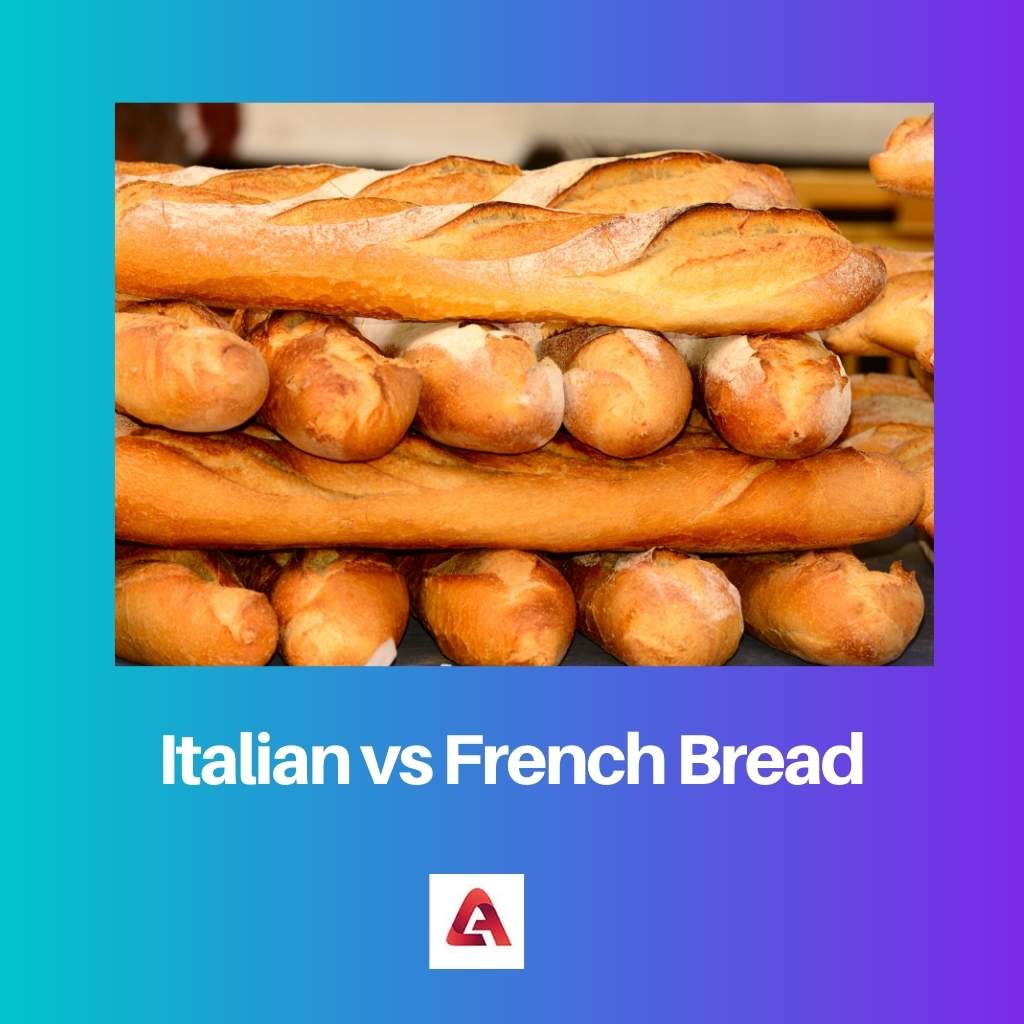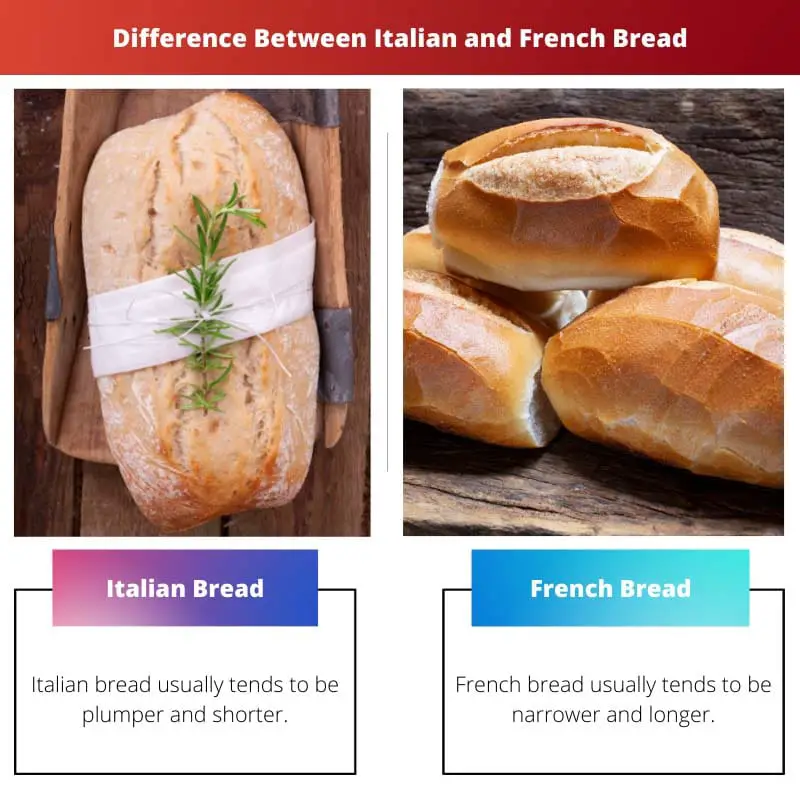Italy and France work in the creation of bread, yet you will see it difficult to strike any similitudes between the two.
Anything from the bread’s heating strategy down to its shape and size is normally done alternately on one or the other side of the Italian-French line.
Probably the most widely recognized varieties to pay special mind to remember the distinctions between bread batter and the fixings utilized.
Key Takeaways
- Italian bread is made with olive oil, while French bread is made with butter or vegetable oil.
- Italian bread has a hard crust and soft interior, while French bread has a crispy crust and light interior.
- Italian bread is wider and flatter than French bread.
Italian vs French Bread
Italian bread is baked in a round and thick shape with a savoury flavour. They are made in the traditional flat stone oven and contain a higher water content. French bread is made longer with a minimum length of 65cm. Some can even go up to 1 meter long. They are soft and fluffy bread made with less sugar and oil. French bread has a sweet and nutty flavour.

Italian bread is known to be heated in a more level and round shape. Italian portions are additionally more limited and commonly thicker than their French partners. All things considered, most Italian bread is formed into bigger rounds.
French bread is commonly heated in a long, slight shape and has turned into the significant food image of the country. The loaf can be prepared up to 30 inches and is a staple in pretty much every district. In France, bread is normally given as a starter.
Comparison Table
| Parameters of Comparison | Italian Bread | French Bread |
|---|---|---|
| Shape | Italian bread tends to be plumper and shorter. | French bread tends to be narrower and longer. |
| Texture | Italian bread has a hard outside, however, the morsel tends to be denser. | French bread has is crusty, with a soft and light crumb. |
| Baking Method | Italian bread is traditionally baked, which is in a flat stone oven. | French bread can be baked in any regular oven. |
| How to Serve | Italian bread is normally filled in as an enhancement to pasta or other principal courses. | French bread is normally served as a starter. |
| Ingredients | Italian bread contains somewhat more milk, olive oil, and sugar. | French bread can not have added oil or fat. |
What is Italian Bread?
Italian bread has customarily been created with advancements, for example, biga and sourdough frameworks.
Italian dough punchers have consistently been known for their remarkable heating procedures and enthusiasm for the workmanship and art of breadmaking.
A few family ages have reliably utilized sourdough frameworks that have been taken care of for quite a long time, even hundreds of years.
There are very few Italian suppers that do exclude bread. Old instruments and stoves give proof that man has been making bread for millennia.
In the same way as other different food sources, antiquated Romans took the speciality of bread production to a more elevated level.
As well as improving the processing methods of wheat, the Romans were quick to deliver flour, which could be prepared into white bread.
Italians have exclusive requirements for their bread. They are known to permit the yeast to completely ascend throughout a few hours, leaving a slender outside.
Italians esteem the size of their portions of bread because each relative should be appropriately sustained.
Italians favour their bread to have a delicate and sodden inside, which is great for engrossing olive oil, vinegar, tomatoes, and other select garnishes.

What is French Bread?
The French have a long history of impacting culinary strategy, from the terms used to portray cooking strategies to the bread eaten day by day by many individuals throughout the planet.
French bread is a trademark portion with firmly controlled fixings. Indeed, French law directs that the portions contain just flour, water, yeast, and salt in differing amounts.
A genuine French bread or loaf is long and slim with a thick, brilliant outside that should snap when crushed. The inside of the bread is springy and grayish in shading, with differing measured holes disseminated all through the inside.
Regardless of its basic fixings, the bread should taste somewhat sweet and nutty with a rich fragrance.
The beginnings of French bread can be found in Vienna in the nineteenth century. Preceding this period, bread was prepared on a dry stove, creating a portion that was less reliable on the surface.
The creation and utilization of the steam broiler took into account the control of temperature and preparing time that delivered a portion of bread with a delicate, smooth inside and thick, earthy colored covering.

Main Differences Between Italian and French Bread
- Italian bread is round, similar to a pizza base, whereas French bread is long and flimsy in shape with adjusted edges.
- Italian bread is allowed to add olive oil, milk, and sugar to make it sweeter as compared to other bread. On the other hand, in French bread, fats or oils are not added.
- Italian breads are baked in traditional ovens, whereas French breads are baked in modern ovens.
- Italian breads are served as add-ons to the classic Italian food, whereas French breads are consumed as starters.
- Italian breads are chewy from the inside, while French breads are crusty and hard.

- https://www.degruyter.com/document/doi/10.1515/9783110861402.55/html
- https://elibrary.ru/item.asp?id=42777084

This is a very interesting article. I never knew that Italian bread is baked in a flat stone oven and has a higher water content while French bread is baked in a modern oven. This is very fascinating.
The article is informative and interesting. I did notice that the article didn’t touch upon the many regional variations of bread in both France and Italy. It would be interesting to explore the variations within each country.
This article provides an in-depth analysis of Italian and French bread, highlighting the variations in ingredients, baking methods, and cultural significance. A fascinating read.
Wow! This article is quite informative and thought-provoking. It’s astounding how much history and tradition goes into baking Italian and French bread. The comparisons at the end of the article are very insightful.
Extraordinary article. It’s surprising to see the differences between Italian and French bread! There are so many subtle differences that I never knew about. I’d love to see more articles like these.
The article is quite remarkable. It’s impressive to see the attention to detail and tradition mentioned in the article. The influence of regional variations would be an interesting topic to explore further.
This article beautifully captures the essence of Italian and French bread. The historical context and detailed descriptions present a vivid picture of the differences between the two. Well done.
I thoroughly enjoyed reading the article. I have always been fascinated by the craftsmanship and artistry in baking. I’ve also noticed that the French are very particular about their bread, and now I understand why.